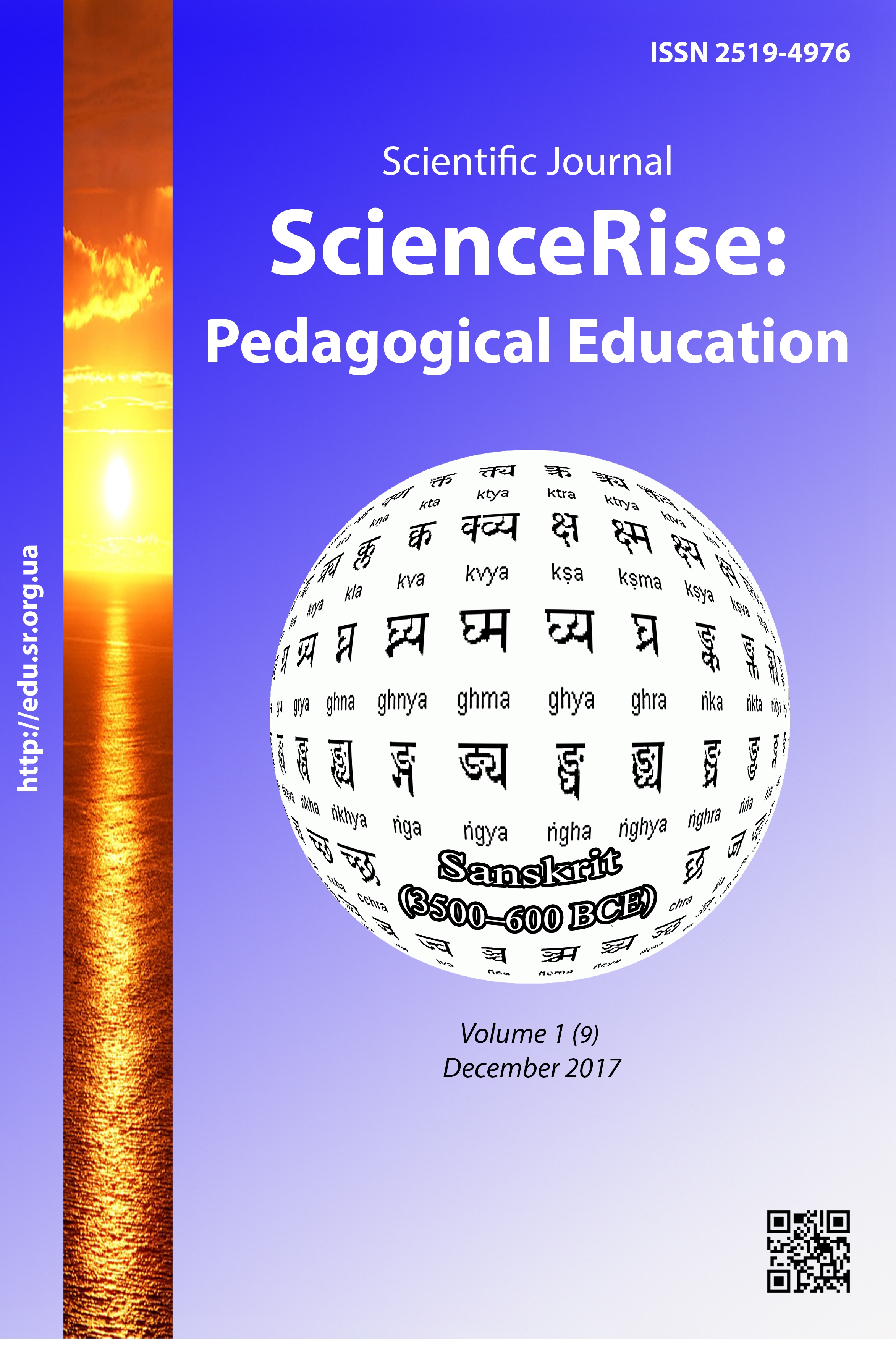The research of didactic games as means of development of cognitive and creative activity of younger schoolboys at labor lessons
DOI:
https://doi.org/10.15587/2519-4984.2017.91484Keywords:
creative development, didactic game, work training, younger schoolchildren, Elementary SchoolAbstract
The article elucidates the problem of development of cognitive and creative activity of young schoolboys in the process of labor study. The recent scientific investigations on the problem of using didactic games in learning-upbringing process of elementary school and their influence on creative development of a child were analyzed. The place and role of labor lessons in the development of cognitive and creative activity of young schoolchildren were determined. The content and features of the development of cognitive and creative activity of children at labor study by the means of didactic game were discovered. The specificity of using didactic games in the process of labor study was considered. The definition of didactic game at labor lessons is offered taking into account the analyzed modern concepts. As a result of experimental study the modern state of using didactic games at labor lessons in elementary school was analyzed. The results of interrogation of elementary school teachers were summarized. The attention was paid to the importance of using didactic games at the labor lessons in elementary school. The main pedagogical conditions of development of creative and cognitive activity of young schoolboys at labor lessons by the means of didactic games were separated: pedagogical stimulation of creative and cognitive activity of a child at labor lessons on the base of personally oriented character of interaction between teacher and pupils; guaranteeing of complex approach in didactic games use at labor lessons; guaranteeing of emotional-sensual comfort at labor lessons by the means of didactic games; intensification of motivational component of creative activity by using didactic games at labor lessons; guaranteeing of differential approach in using didactic games in the process of labor study in elementary school. The necessity of searching rational ways and distinct concretization of mechanism of using didactic games at labor study is emphasized. The pedagogical expedience of using didactic games at labor lessons is consideredReferences
- Vasylenko, T. A. (2005). Otsinka pedagogichnoi systemy Fr. Frebelya vitchyznianymy dijachamy doshkilnogo vyhovannya [Assessment of educational system Fr. Froebel national figures preschool]. Naukovi zapysky Nizhyns'kogo derzhavnogo universytetu imeni Mykoly Gogolja. Psyhologo-pedagogichni nauky, 1, 186–190.
- Amonashvili, Sh. А. (1983). Zdravstvujte, deti! [Hello children]. Moscow: Prosveshchenie, 208.
- Lysenkova, S. N. (2007). Ja chytayu. Ja schytayu. Ja pyshu: Kak uchyt malenkyh [I am reading. I believe. I write: How to teach young]. Moscow: Dortranspechat', 78.
- Маkarenko, A. S. (1960). Vyhovannya v pratsi [Education for work]. Vol. 4. Moscow: APN RSFSR, 593.
- Suhomlinskiy, V. A. (1979). Izbrannye proizvedeniya [Selected works]. Vol. 4. Kyiv: Rad. shkola, 669.
- Shatskiy, S. T. (1980). Izbrannye pedagogicheskie sochinenia [Selected pedagogical works]. Vol. 2. Moscow: Pedagogika, 416.
- Pidkasystiy, P. I. (1972). Samostojatelnaya dejatelnost uchashchyhsya. Didakticheskiy analiz protsessa i struktura vosproizvedenia i tvorchestva [Independent activities of students. Didactic analysis of the process and the structure of play and creativity]. Мoscow: Pedagogika, 184.
- Kudykina, N. V. (2003). Igrova diyalnist moldshyh shkolyariv u pozaurochnomu navchalno-vyhovnomu protsesi [Playing activity of younger students in extracurricular educational process]. Kyiv: КМPU, 272.
- Bogojavlenskaya, D. B. (1981). Pyti k tvorchestvu [Ways to creativity]. Moscow: Znanie, 96.
- Vygotskiy, L. S. (1991). Tvorchestvo i voobrazenie v detskom vozraste [Creativity and imagination in childhood]. Moscow: Prosveschenie, 93.
- Molyako, V. A. (1991). Tvorcheskaya odarоnnost i vospitaniye tvorcheskoy lichnosti [Creative talent and education of creative personality]. Kyiv: Znanie, 20.
- Ponomarov, Ja. A. (1976). Psihologiya tvoschestva i pedagogika [Psychology of Creativity and Pedagogy]. Moscow: Nayka, 280.
- Navchannya і vyhovannya uchniv 1 klasu [Training and education of students grade 1] (2002). Kyiv: Pochatkova shkola, 464.
- Navolokova, N. P. (2012). Entsyklipediya pedogogichnyh tehnologiy ta innovatsiy [Encyclopedia of educational technology and innovation]. Kharkiv: Оsnova, 176.
- Jarmachenko, M. D. (Ed.) (2001). Pedagogichnyj slovnyk [Teaching Dictionary]. Kyiv: Pedagogichna dumka, 514.
- Klarin, M. V. (1995). Innovatsii v mirovoy pedagogike: obuchenie na osnove issledovaniya, igry i diskussii [Innovations in the world pedagogy: learning through research, discussion and games]. Riga: Eksperiment, 176.
- Vygotskiy, L. S.; Davydov, V. V. (Ed.) (1997). Pedagogicheskaya psihologiya [Pedagogical psychology]. Мoscow: Pedagogika, 480.
- Kudykina, N. V. (2005). Vnesok vitchyznyanyh psyhologiv u formuvannya pedagogichnoi teorii igrovoi diyalnosti ditey [The contribution of local psychologists in educational theory formation of play children]. Practical Psychology and Social Work, 1, 7–9.
- Makarenko, A. S. (1987). Sobranie sochineniy [Collected works]. Vol. 1. Мoscow: Pravda, 575.
- Starovoit, L. V. (2010). Pedagogichni umovy tvorchogo rozvytku molodshyh shkolyariv u protsesi trudovogo navchannya [Pedagogical conditions of creative development of younger students in the course of labor training]. Naukovi zapysky, 261–266.
Downloads
Published
How to Cite
Issue
Section
License
Copyright (c) 2017 Леся Василівна Старовойт

This work is licensed under a Creative Commons Attribution 4.0 International License.
Our journal abides by the Creative Commons CC BY copyright rights and permissions for open access journals.
Authors, who are published in this journal, agree to the following conditions:
1. The authors reserve the right to authorship of the work and pass the first publication right of this work to the journal under the terms of a Creative Commons CC BY, which allows others to freely distribute the published research with the obligatory reference to the authors of the original work and the first publication of the work in this journal.
2. The authors have the right to conclude separate supplement agreements that relate to non-exclusive work distribution in the form in which it has been published by the journal (for example, to upload the work to the online storage of the journal or publish it as part of a monograph), provided that the reference to the first publication of the work in this journal is included.








